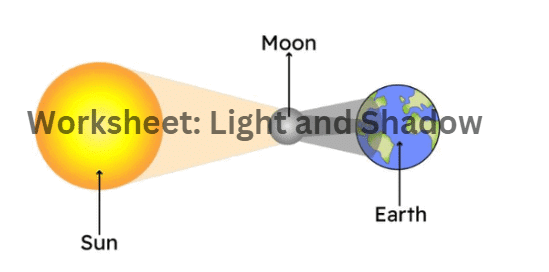Class 5 Science - Light and Shadow - CBSE Worksheets - 2

Cause & Effect Questions
(i) Why do shadows change size during the day?
(ii) Why does a solar eclipse not happen every new moon?
(iii) What happens to an object’s shadow when the light source moves closer to it?
(iv) Why does the Moon appear to glow even though it is not a source of light?
(v) Why do objects appear dark when placed in the shadow?
Find the Error in Statement & Correct It
(i) A lunar eclipse occurs when the Moon blocks the Sun’s light from reaching the Earth.
(ii) A shadow forms on the same side as the light source.
(iii) The Sun is the only source of light in the universe.
(iv) During a solar eclipse, the Earth comes between the Sun and the Moon.
(v) Shadows remain the same size throughout the day.
Arrange in Correct Order
(i) Arrange the steps of a Solar Eclipse in the correct order:
(a) The Moon comes between the Sun and the Earth.
(b) The Sun’s light is blocked by the Moon.
(c) A shadow is cast on Earth.
(d) People in some areas see a total or partial eclipse.
(ii) Arrange the sequence of Shadow Formation:
(a) Light travels in a straight line.
(b) An opaque object blocks the light.
(c) A dark area appears behind the object.
Real - Life Application-Based Questions
(i) You are playing outside in the evening, and your shadow is very long. What does this tell you about the position of the Sun?
(ii) You stand under a tree on a hot sunny day and feel cooler. Why does this happen?
(iii) Your friend claims that the Moon is a source of light. How would you correct them?
(iv) A person standing near a streetlight casts a shorter shadow than someone standing farther away. Why?
(v) A rainbow appears after a rain shower. What natural process is responsible for this?

Differentiate between the following
(i) Differentiate between Solar and Lunar Eclipse.(ii) How is an umbra different from a penumbra?
(iii) What is the difference between Opaque and Translucent materials?
What If : Questions
(i) What if the Earth had no atmosphere? How would the sky look during the daytime?
(ii) What if the Moon disappeared? How would it affect eclipses?
(iii) What if the Sun never set? What would happen to shadows?
(iv) What if all objects were transparent? Would shadows exist?
(v) What if the Moon had its own light source? How would that change our nights?
|
45 videos|202 docs|45 tests
|
FAQs on Class 5 Science - Light and Shadow - CBSE Worksheets - 2
| 1. What are the basic principles of light and shadow? |  |
| 2. How do light and shadow affect the perception of depth in art? |  |
| 3. What is the difference between hard and soft shadows? |  |
| 4. How can I use light and shadow to enhance my photography? |  |
| 5. What role do light and shadow play in our daily lives? |  |

















